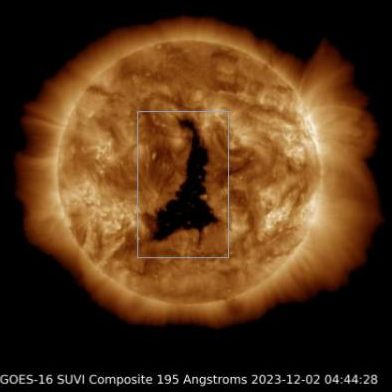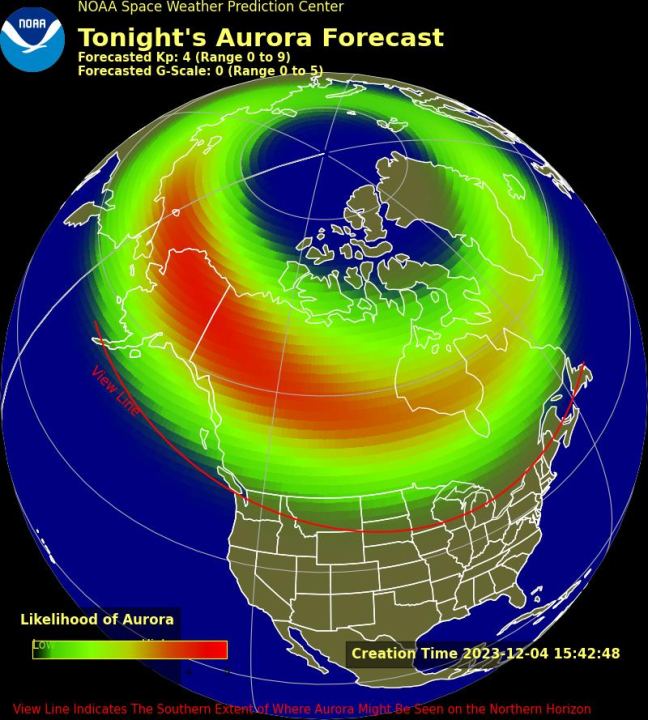Geomagnetic storm likely to impact Earth through Tuesday: What we know
(NEXSTAR) — Last week, many were treated to a dazzling display of auroras thanks to strong solar activity. This week, the Earth is likely to be impacted by even more solar activity, without the aerial color show.
Over the weekend, NOAA’s Space Weather Prediction Center (SWPC) issued a geomagnetic storm watch for Monday and Tuesday, saying a “high speed stream from a coronal hole is expected to influence the Earth” on both days.
Arrival was set for Monday morning, according to SWPC.
They even shared this minorly daunting image of the sun, which shows the coronal hole.

Does this mean the sun is about to explode or the Earth is going to melt? No, but there are some other impacts we may experience.
What you’re seeing in the image above is, as we mentioned, a coronal hole. It appears darker than the rest of the sun because the area is cooler and less dense than the surrounding plasma, according to NOAA. Areas such as this one are “unipolar magnetic fields,” which allow solar wind to release into space “more readily.”
These events happen often, Rob Steenburgh of NOAA’s Space Weather Forecast office previously told Nexstar. Coronal holes and their associated solar winds are able to cause geomagnetic storms like the one the SWPC is warning about this week.
The SWPC uses a scale, similar to those used to measure tornadoes or hurricanes, to categorize the strength of a geomagnetic storm. The impending storm is expected to reach G1 or G2 strength, falling on the lower end of the five-point scale.
A G1 storm can bring the northern lights to Maine and Michigan’s Upper Peninsula, while a moderate G2 storm can shine them as far south as New York and Idaho. Late last week, we experienced a G3 level storm, capable of bringing the northern lights as far south as northern Missouri.
Unfortunately, according to the SWPC’s latest forecast, the chances of a widespread northern light display in the Lower 48 (Alaska usually has at least a small likelihood of seeing them every night) is looking relatively slim with this geomagnetic storm. Those as far south as central South Dakota, Wisconsin and Michigan have a small chance at seeing the northern lights based on the red line seen on the map below.

So if we likely won’t see the northern lights on Monday, what is the SWPC concerned about?
While the northern lights are harmless, the solar activity associated with geomagnetic storms can impact our navigation, communication and radio signals.
We’ve seen some of those serious impacts before. There was the Great Halloween Solar Storms of 2003 caused by a series of powerful CMEs, NOAA reports. They brought dazzling northern lights displays as far south as California, Texas, and Florida — states that rarely ever see them — and caused other (less awe-inspiring) technical problems.
Half of the spacecraft orbiting Earth were impacted, causing disruptions to GPS, radio communication and satellite TV. A satellite was damaged beyond repair while astronauts aboard the International Space Station had to shield themselves from high radiation. On Earth, science groups in Antarctica lost communications for five days and GPS systems elsewhere were affected.
This storm likely won’t have that large of an impact. In fact, unless you do get a glimpse at the northern lights Monday night, you probably won’t notice the storm has influenced earth at all.
You can, however, expect to see the northern lights more often in the coming months. The sun is nearing the peak of its Solar Cycle 25, an 11-year period in which it flips its north and south poles. During this time, various space weather events can occur that can bring geomagnetic storms — and the northern lights — to us on Earth.
Copyright 2023 Nexstar Media Inc. All rights reserved. This material may not be published, broadcast, rewritten, or redistributed.

